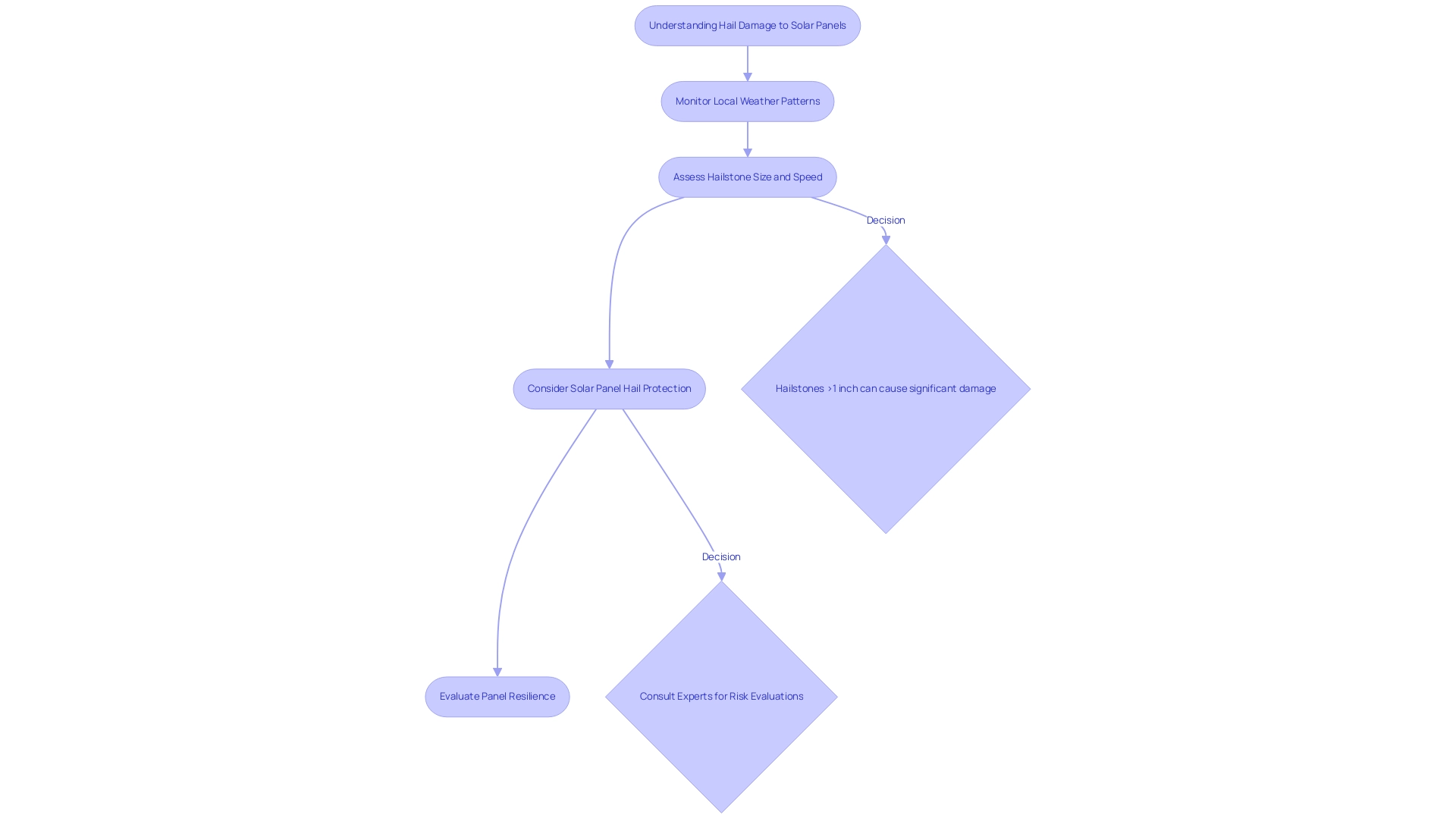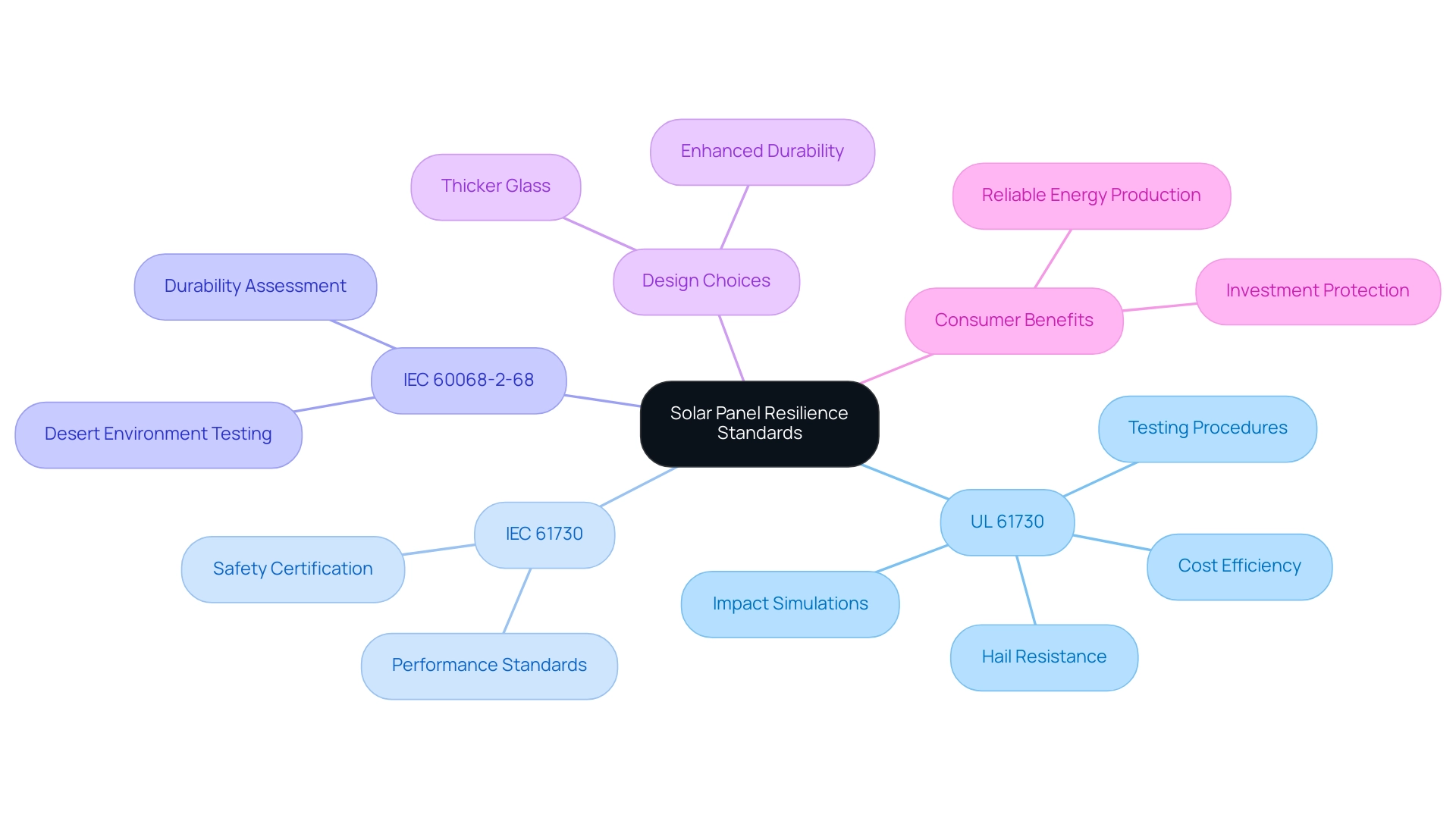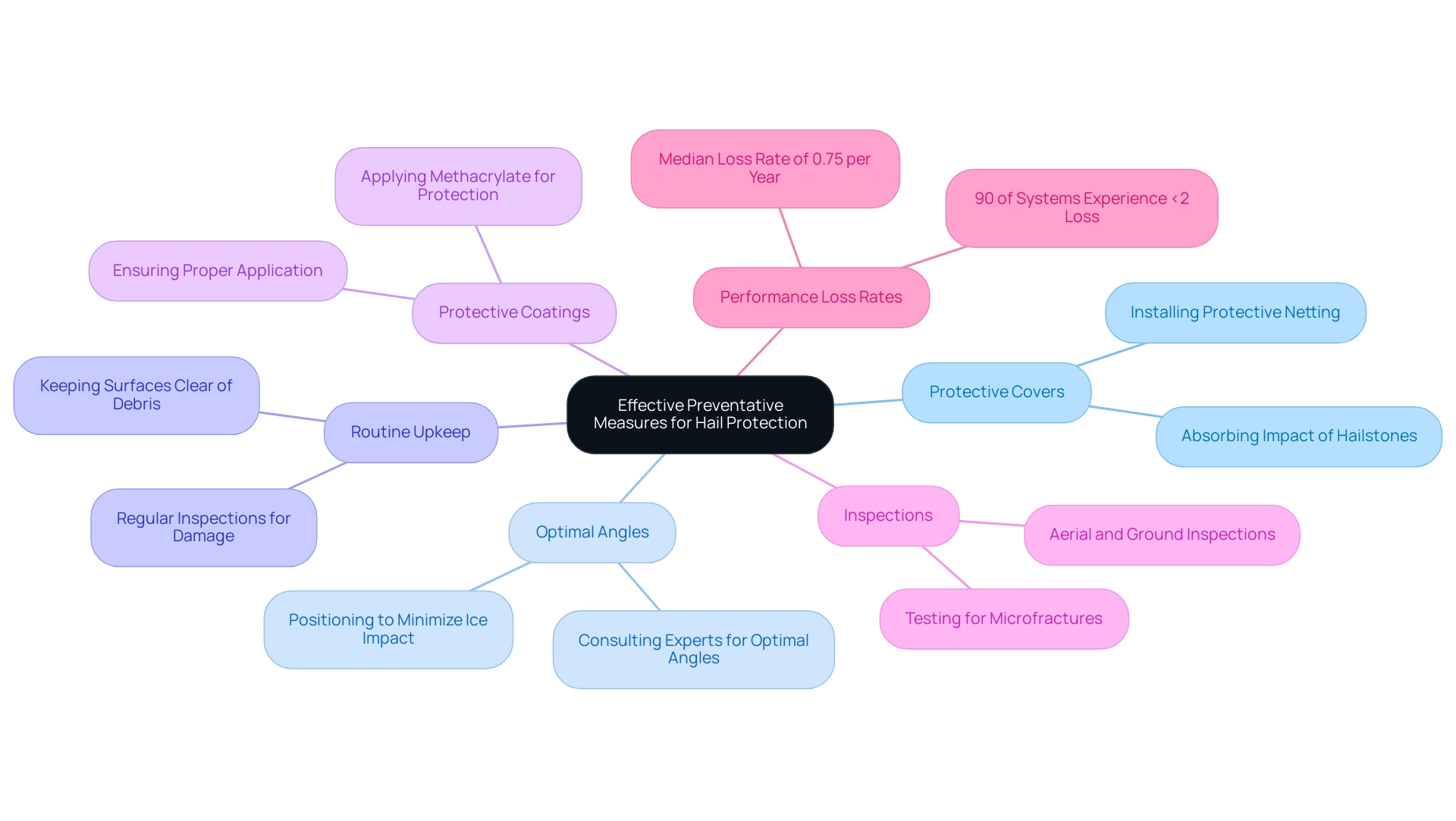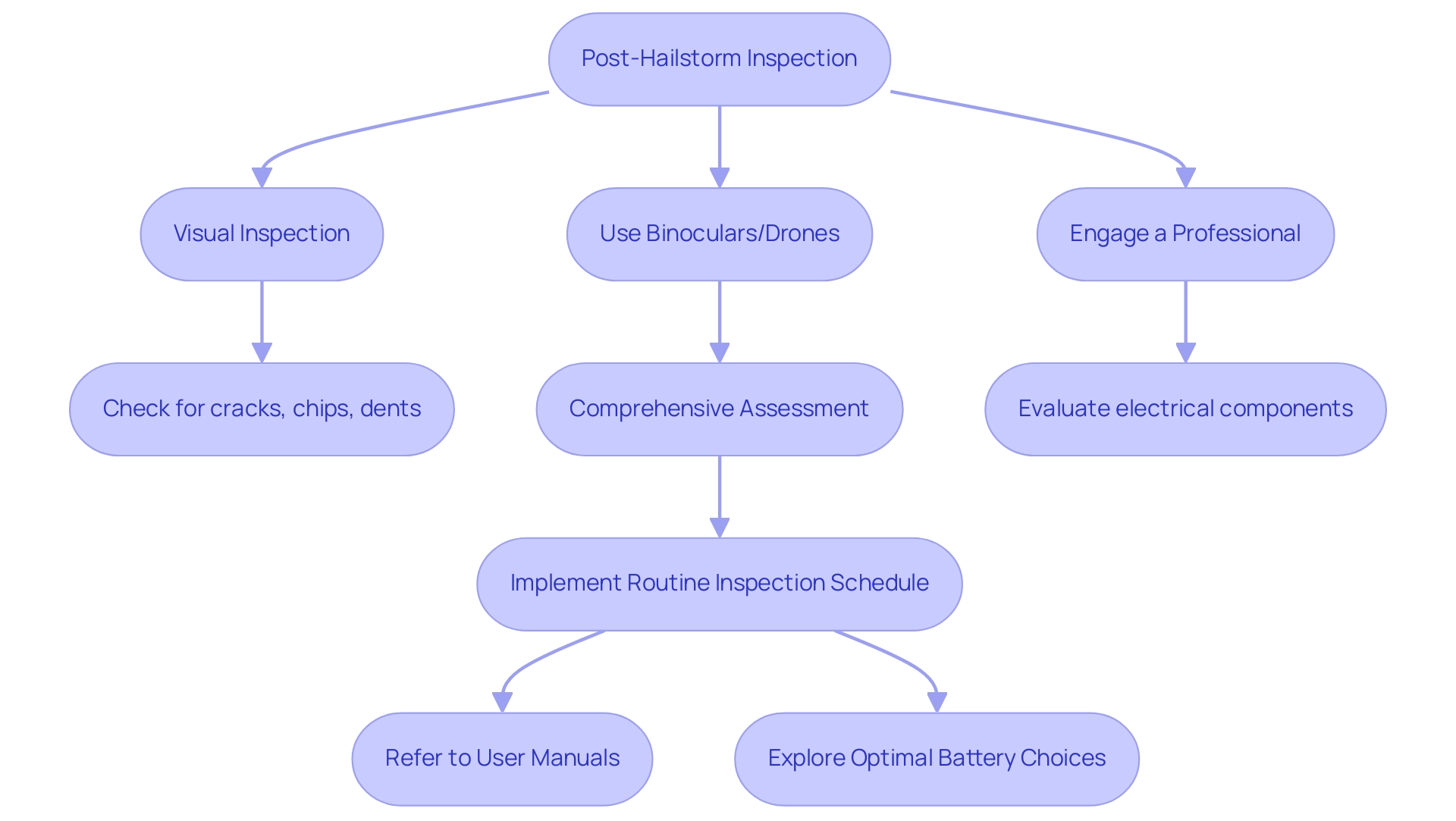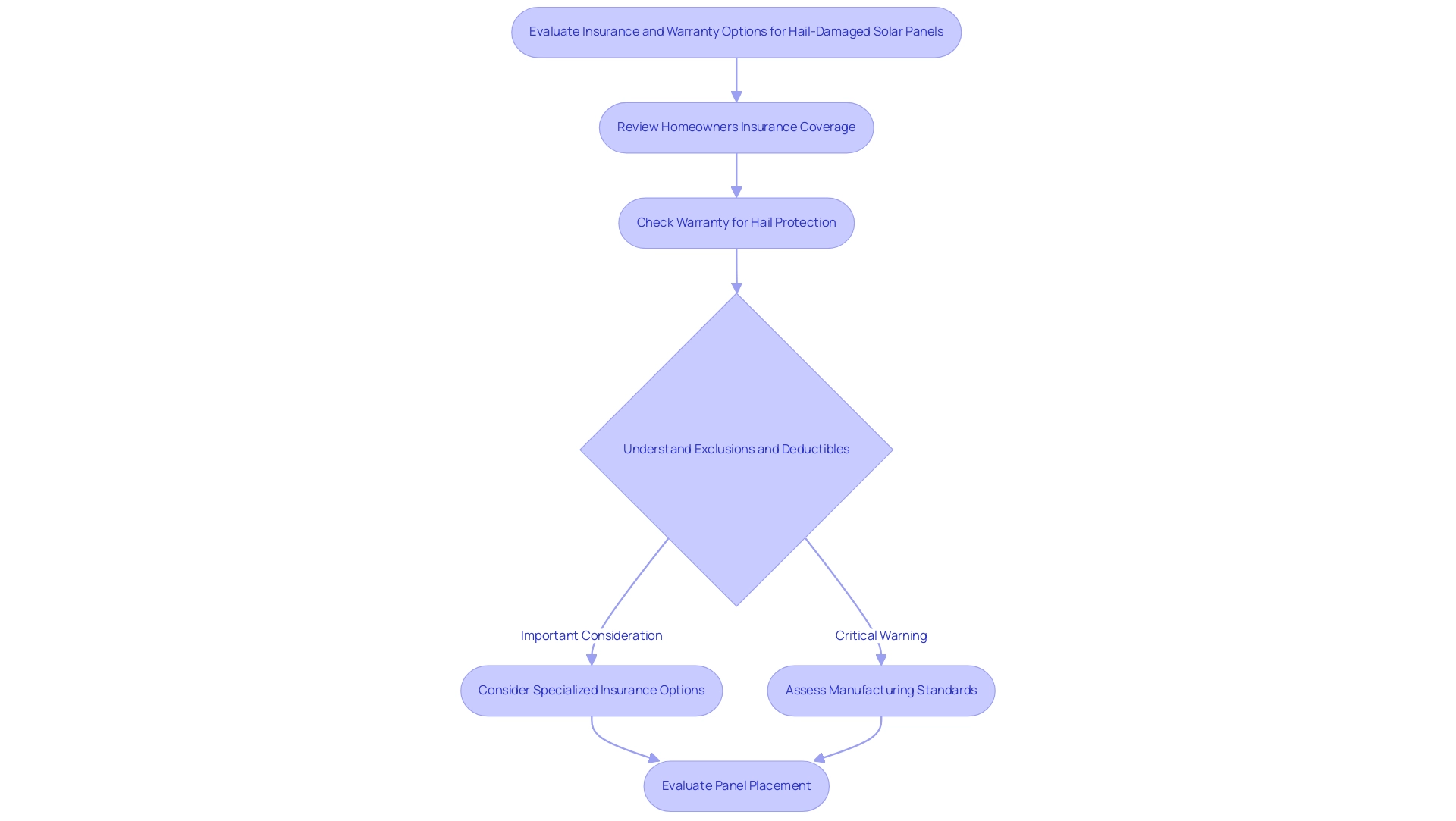Overview
Caring for your home means taking proactive steps to protect your solar panels from hail damage, especially during severe weather. We understand that energy bills can be a concern, and safeguarding your investment is essential. By implementing effective measures for solar panel hail protection, you can mitigate potential damage and ensure the longevity of your solar energy system.
Understanding the risks associated with hail is crucial. Utilizing protective covers not only shields your panels but also enhances their efficiency. It’s important to ensure compliance with safety standards, which can provide peace of mind during storms. Regular inspections can help maintain your system’s performance and extend its life, allowing you to enjoy the benefits of energy independence.
Together, we can navigate these challenges. By taking these protective measures, you not only protect your home but also embrace a sustainable future. Let’s work towards ensuring your solar energy system remains efficient and reliable, allowing you to focus on what truly matters. Remember, we are here to support you every step of the way.
Introduction
In light of increasingly severe weather patterns, many homeowners and energy enthusiasts are understandably concerned about the vulnerability of solar panels to hail damage. Hailstorms can cause significant harm to these renewable energy systems, resulting in costly repairs and reduced efficiency.
It’s vital for anyone looking to protect their solar investment to grasp the risks associated with hail, including the size and speed of hailstones. This article aims to provide you with insights into the impact of hail on solar panels, explore resilience standards and ratings, outline effective preventative measures, and emphasize the importance of thorough post-storm inspections.
Additionally, we will highlight the significance of navigating insurance and warranty options to ensure comprehensive coverage. By equipping yourselves with knowledge and proactive strategies, together we can safeguard your solar energy systems against the unpredictable forces of nature.
Understanding Hail Damage and Its Impact on Solar Panels
Hail poses a significant threat to the protection of solar panels, primarily by causing the cracking or shattering of the tempered glass that safeguards the photovoltaic cells. We understand that when hailstones strike, they can create micro-cracks that may not be immediately visible but can lead to a gradual decrease in efficiency over time. Research indicates that hailstones larger than one inch can cause significant harm, especially when descending at high velocities.
In fact, during the first half of 2023, over 7,000 reports of severe thunderstorm winds and associated damage were documented, highlighting the increasing frequency of such weather events.
Contemporary photovoltaic panels are designed to withstand certain levels of ice impact; however, implementing solar panel hail protection is essential as severe weather conditions can still present a danger. A thorough understanding of the size and speed of hailstones is crucial for homeowners. For example, while all photovoltaic modules must adhere to IEC/UL 61730 safety standards, many are evaluated at lower thresholds for precipitation resistance.
Companies like Powercore Electric, aiming to enhance their resilience against severe weather, may opt for additional testing, albeit at a higher cost. It’s common to feel concerned about the expense to substitute a broken solar panel, which is generally below $1,000, underscoring the financial consequences of severe weather.
Professional insights emphasize the importance of pre-construction risk evaluations and expert consultations to reduce potential harm. As noted by Brian Allen, a senior risk engineer with Aon Global Risk Consulting Services, “However, increased understanding on stowage operational policies and additional sources of independently validated publicly available data are required to support this.” This emphasizes the significance of being proactive in understanding risks related to damage from severe weather.
Furthermore, homeowners should contemplate how cleaning services for their energy collection systems can aid in preserving the efficiency of their setups, particularly after hailstorms. Practical instances demonstrate the effect of precipitation on photovoltaic efficiency. A case study on resilience in photovoltaic module manufacturing revealed that while minimum safety requirements are met, many units may not endure severe impacts without additional testing for solar panel hail protection.
Homeowners should regularly monitor local weather patterns and consider protective measures, such as solar panel hail protection and investing in Tesla home chargers that can be integrated with energy solutions, to safeguard their investments against potential hailstorms. Together, we can work towards ensuring your solar energy systems remain effective and resilient, providing peace of mind in the face of unpredictable weather.
Evaluating the Resilience of Solar Panels: Standards and Ratings
When considering photovoltaic modules, we understand that homeowners often prioritize durability and protection against harsh weather conditions, such as hail. It’s crucial to ensure that the solar panels chosen can withstand ice impacts. The UL 61730 and IEC 61730 standards serve as essential benchmarks for assessing the durability of these modules. Panels meeting these standards have undergone rigorous testing, simulating impact events to guarantee their resilience in regions prone to adverse conditions.
Notably, the UL 61730 standard integrates the stringent testing procedures of UL 1703 and IEC 61730, offering a comprehensive safety and performance certification recognized both in North America and internationally. Additionally, the IEC 60068-2-68 testing evaluates the performance of photovoltaic modules in sandy desert environments, ensuring they remain durable against various challenges, including hail.
Statistics reveal that a significant percentage of photovoltaic systems are now rated for hail resistance. Many manufacturers are opting for thicker glass—typically at least 4 mm—to enhance solar panel hail protection. This thoughtful design choice not only bolsters durability but also contributes to the overall longevity of your installation. Furthermore, the integration of UL 61730 has reduced the number of samples required for testing, decreasing both testing time and costs for manufacturers. This efficiency can ultimately benefit consumers by ensuring more readily available products.
We encourage homeowners to consult with their installation specialists, such as those at Powercore Electric, to ensure they choose systems with solar panel hail protection that adhere to these resilience standards. By doing so, you safeguard your investment and ensure dependable energy production, even in adverse weather conditions. It’s also important to note that products previously certified to UL 1703 can continue to bear the UL Mark until UL 1703 is withdrawn, maintaining their relevance in today’s market. Additionally, exploring government programs that support energy adoption can provide further assistance, while considering the economic and environmental benefits of integrating renewable solutions into your home.
Together, let’s work towards a sustainable future that not only addresses your energy needs but also contributes positively to the environment.
Effective Preventative Measures for Hail Protection
As homeowners, we often worry about the potential damage to our energy systems, especially when it comes to the threat of hail. It’s completely understandable to seek effective ways to protect your photovoltaic systems from such impacts. One of the most efficient choices available is the installation of protective covers or netting specifically designed for these systems. These protective solutions are crafted to absorb the impact of hailstones, preventing direct contact with the surfaces and significantly reducing the risk of harm.
Moreover, the angle at which photovoltaic systems are positioned is crucial in minimizing ice impact. Studies indicate that structures positioned at optimal angles can greatly lower the chances of ice-related damage. We encourage homeowners to consult with installation experts to determine the best angle tailored to their specific location and climate conditions.
Routine upkeep is another vital aspect of safeguarding photovoltaic modules. Keeping the surfaces clear of debris not only enhances their efficiency but also minimizes the risk of damage during hail events. A clean surface allows for better visibility during inspections, ensuring that any potential issues can be identified early on.
As highlighted in recent studies, maintaining clean energy devices is essential for optimizing their efficiency and boosting energy production. Dust, dirt, and debris can obstruct sunlight, leading to performance declines that accumulate over time. An expert once noted, “Did you notice a significant drop in energy production? This issue can stem from various factors, with dust and debris buildup being the most common.”
Investing in energy systems equipped with solar panel hail protection is a wise decision for homeowners concerned about stormy conditions. These structures are designed with higher durability ratings, providing an added layer of protection against hail impacts. Recent advancements in photovoltaic technology have led to the creation of materials that withstand larger hailstones without compromising performance.
Additionally, case studies have shown that applying protective coatings, such as methacrylate, can be a cost-effective solution for enhancing the durability of solar devices. This spray-on solution allows sunlight to penetrate while offering a protective shield against adverse weather effects, provided it is applied accurately and in moderation. The case study titled ‘Applying Methacrylate for Protection’ illustrates how proper application is crucial to maintaining the panels’ energy collection capabilities.
In light of recent weather patterns, it is vital for homeowners to stay informed about best practices for assessing damage from ice pellets. This includes conducting aerial and ground inspections, testing for microfractures, and evaluating the overall impact on the energy installation. By analyzing data from ice pellet sensors, understanding the distribution of ice stone sizes and the number of impacts per size class per event can provide valuable insights into potential risks.
Moreover, as Johan Jaques, a meteorological consultant, points out, “Electrical separation can occur in photovoltaic systems, rendering sections of a cell inactive.” This highlights the importance of understanding the possible effects of hail damage on the performance of photovoltaic systems. By taking these proactive measures, homeowners can ensure their energy systems remain safe and efficient, even in the face of severe weather, while also contributing to a more sustainable and environmentally friendly home.
Additionally, data indicates that the median loss rate for photovoltaic system performance is 0.75% per year, with 90% of systems experiencing less than a 2% loss each year. Routine maintenance can help reduce these losses, ensuring that your devices continue to supply cost-effective and dependable energy.
Post-Hailstorm Inspection and Maintenance for Solar Panels
After a hailstorm, we understand how important it is for eco-conscious homeowners to evaluate their solar systems thoroughly. Ensuring adequate solar panel hail protection is vital for maintaining ongoing efficiency and safety. Start by inspecting the surfaces for visible signs of damage, such as cracks, chips, or dents in the glass. Even minor imperfections can significantly reduce energy output, making it crucial to address any issues without delay.
For a safer inspection, consider utilizing binoculars or a drone to evaluate the surfaces from a distance. This approach not only keeps you safe but also allows for a comprehensive assessment.
In addition to a visual check, it’s wise to engage a professional for a thorough evaluation. Specialists can assess not only the physical state of the surfaces but also examine the electrical elements for any possible problems arising from ice impacts. Research indicates that hailstorms can lead to a power reduction of up to 12.5% for poly-crystalline modules, underscoring the importance of prompt inspections.
Moreover, a case study titled “Impact of Hailstorm on PV Module Performance” revealed that ice pellets can significantly diminish both power generation and the lifespan of photovoltaic modules, with a notable power reduction of 34.5% observed in Module II of the 4-busbars poly-crystalline modules. This highlights the need for vigilance in maintaining your solar investment.
Brian Allen, a senior risk engineer with Aon Global Risk Consulting Services, emphasizes that in hail-prone areas, using tempered-glass surfaces is essential for ensuring solar panel hail protection. This choice not only enhances durability but also aligns with the economic and environmental advantages of heating systems for homeowners. Routine maintenance inspections are crucial for ensuring that photovoltaic systems function at optimal efficiency.
Therefore, implementing a routine inspection schedule can help safeguard your investment, maintain energy independence, and contribute to long-term sustainability. Together, we can ensure your solar system continues to perform at its best. Homeowners are also encouraged to refer to user manuals for detailed maintenance procedures and to explore optimal battery choices for efficient energy storage, ensuring a comprehensive approach to energy management. Let’s work towards a sustainable future together.
Navigating Insurance and Warranty Options for Hail-Damaged Solar Panels
As a property owner, you may be understandably concerned about ensuring that your insurance policies adequately cover damage to your photovoltaic modules, especially when it comes to solar panel hail protection. While many homeowners’ insurance policies typically include coverage for renewable energy installations, it’s essential to carefully examine the specifics, such as deductibles and potential exclusions. It’s important to note that many standard guarantees for photovoltaic systems often do not cover damage caused by severe weather events, which underscores the necessity of solar panel hail protection against ice pellets.
We recommend checking whether your photovoltaic system warranty explicitly includes solar panel hail protection from severe weather damage. As we look ahead to 2025, it’s vital for property owners to be particularly aware of common exclusions in their insurance policies. For example, coverage for windstorm losses may not extend to electrical components or rented panels, and claims are frequently settled at cash value instead of replacement cost.
This highlights the importance of having a conversation with your insurance provider to ensure you have comprehensive protection. You might also want to consider specialized insurance policies that offer enhanced coverage against storm damage, including solar panel hail protection, which can provide you with peace of mind in the face of unpredictable weather.
Additionally, understanding the manufacturing standards for energy modules can guide your decisions. For instance, all photovoltaic panels must undergo a test involving ice spheres of at least one inch in diameter being fired at the module without shattering the glass. While manufacturers may opt to test against larger ice pellets, many adhere to the minimum requirement, which may not adequately reflect the risks in areas susceptible to such precipitation.
Choosing durable photovoltaic modules can significantly enhance resilience against ice damage while incorporating solar panel hail protection, ensuring that your investment is safeguarded and aligns with your long-term sustainability goals.
To further mitigate ice damage, consider the placement of your panels. Stow angles between 30 degrees and 65 degrees, and possibly up to 75 degrees, are commonly used for stowage solutions, which can help lessen the impact of precipitation. As Dan Schreiber, Vice President in J.S. Held’s Forensic Meteorology service line, points out, understanding the risks associated with extreme weather events is crucial for homeowners. This reinforces the importance of selecting modules that offer solar panel hail protection and meet or exceed the minimum hail testing standards, as outlined in the case study on manufacturing requirements for such modules.
By integrating these considerations into your solar energy strategy, you not only protect your investment but also contribute to a more sustainable future. Together, we can navigate these challenges and work towards a more resilient and eco-friendly energy solution.
Please remember that this publication is for educational purposes only and does not constitute specific legal advice.
Conclusion
We understand that hail damage can pose a significant threat to your solar panels, primarily through the cracking of the tempered glass that protects the photovoltaic cells. Hailstones larger than one inch can cause severe damage, which is why it’s essential for homeowners like you to choose resilient solar panels that meet standards such as UL 61730 and IEC 61730. These standards ensure that your panels have undergone adequate testing for hail resistance.
To protect your solar investment, implementing preventative measures is crucial. Consider:
- Installing protective covers
- Optimizing panel angles
- Maintaining cleanliness
These actions can significantly reduce the risk of damage. Investing in hail-resistant panels designed with thicker glass also provides added protection. After a hailstorm, it’s vital to conduct thorough inspections to identify any damage that may affect efficiency.
Navigating insurance and warranty options is equally important. Ensure your insurance policies adequately cover hail damage and verify whether your solar panel warranties include such events. Understanding these details, along with considering specialized solar insurance, can offer you peace of mind.
In summary, by being proactive about hail risks, resilience standards, and protective measures, you can effectively safeguard your solar energy system. Together, we can enhance the longevity and efficiency of your installation, contributing to a sustainable future. Let’s ensure that solar energy remains a reliable and eco-friendly solution for you.



